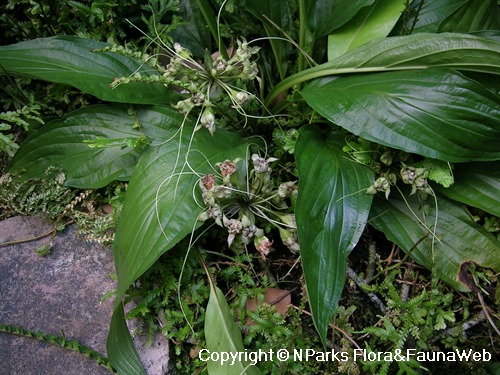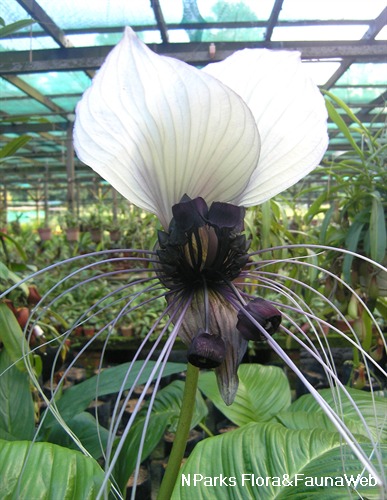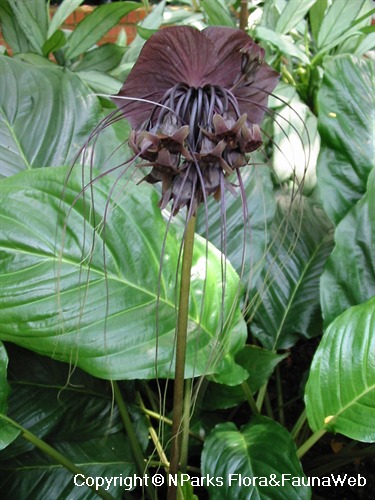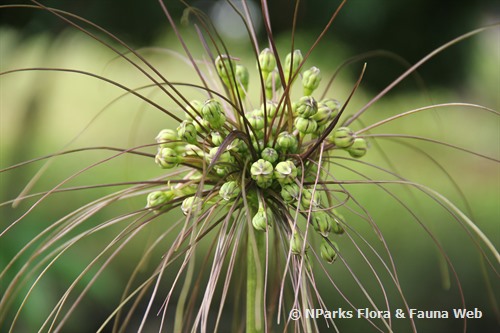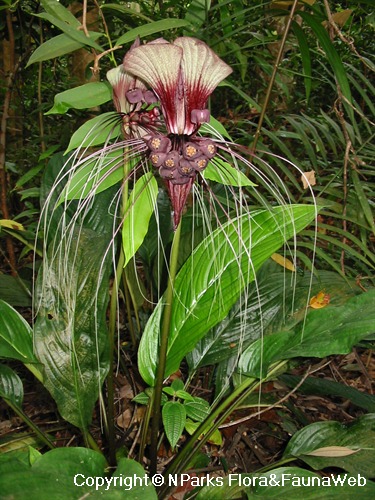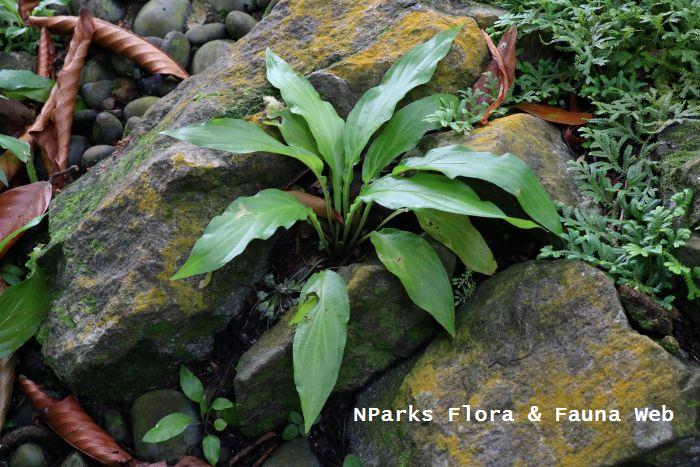
Back
Tacca plantaginea (Hance) Drenth
| Family Name: | Dioscoreaceae |
| Synonyms: | Schizocapsa plantaginea Hance |
| Common Name: | False Tacca |
The False Tacca (Tacca plantaginea) is a low-growing, herbaceous plant that naturally grows on the river edges. It produces bizarre inflorescences and dehiscent fruits that splits upon maturity, releasing many seeds dispersed by water. It can be grown in shady bioswales
Name
Classifications and Characteristics
| Plant Division | Angiosperms (Flowering Seed Plants) (Monocotyledon) |
|---|---|
| Plant Growth Form | Herbaceous Plant |
| Lifespan (in Singapore) | Perennial |
| Mode of Nutrition | Autotrophic |
| Plant Shape | Fountain (Palm-like), Irregular |
Biogeography
| Native Distribution | South China, Laos, Vietnam, Thailand. |
|---|---|
| Native Habitat | Terrestrial (Riverine) |
| Preferred Climate Zone | Tropical, Sub-Tropical / Monsoonal |
| Local Conservation Status | Non-native (Horticultural / Cultivated Only) |
Description and Ethnobotany
| Growth Form | It is an evergreen, perennial herbaceous plant that grows no more than 15 - 20 cm. |
|---|---|
| Foliage | The leaves are green, lanceolate, 10-35 cm long by 3-8 cm wide, with depressed veins. The petiole is 8-30 cm long. The leaves are arranged in a rosette. |
| Stems | It has underground, cylindrical rhizomes (thick, horizontal modified stems). |
| Flowers | The inflorescence is an umbellate cymose, subtended by two pairs of small, green involucral bracts, 0.5-3 cm long by 0.3-2 cm wide, and several thread-like bracteoles, each up to 8 cm long. Each flower has six greenish-white to dark purple tepals (a term for petals and sepals), six light-green to light-purple stamens and a pistil with a tri-lobed stigma. The flower is attached to a 1.5-3 cm long pedicel (a flower stalk). The inflorescences and flowers are found between and/or under the foliage. It is likely that this species exhibits autogamy (self-pollination). <2 & 4> |
| Fruit | The fruit is a trilocular (three-valved) capsule (a dry, dehiscent fruit) that recurves when split, revealing grey, oblong-ovoid seeds. <1> The seeds are dispersed by rainfall and river water. |
| Habitat | It can be found in dry evergreen and mixed deciduous forests usually by streams, 100–600 m above sea level. <3> |
| Taxonomy | The genus Tacca was previously categorised in its own family (Taccaceae) but has now been subsumed into Dioscoreaceae under APG II (2003). |
| Cultivation | It does well in moist but well-draining soil and shady conditions. It can grow in full shade, but the leaves might etiolate. It requires high humidity due to its close proximity to moving water bodies in its natural habitat. It can be propagated by seeds or division. |
| Etymology | The genus Tacca is from a Malayan vernacular name, taka, 'arrowroot'. The specific epithet plantaginea refers to its resemblance to plantains (family: plantaginaceae; not to be confused with the banana-like fruit, of the same name.) |
Landscaping Features
| Landscaping | It is suitable for shaded or partially-shaded, moist areas in parks and gardens or in shady bioswales with inundating water levels. It can also be grown in container planting. |
|---|---|
| Desirable Plant Features | Ornamental Form, Ornamental Flowers |
| Landscape Uses | Riverine, Container Planting, Groundcover, Parks & Gardens, Small Gardens, Interiorscape/ Indoor Plant |
| Thematic Landscaping | Bioswales / Sunken Garden, Naturalistic Garden |
| Usage Hazard - Cons | Toxic Upon Ingestion |
| Usage Hazard - Cons Remarks | Toxic if ingested: The plant contains taccalonolides, and while it's not known to be toxic to humans, it may cause allergic reaction. It can be toxic to cats and dogs. |
Fauna, Pollination and Dispersal
| Pollination Method(s) | Abiotic (Self-Pollinated) |
|---|---|
| Seed or Spore Dispersal | Abiotic (Explosive Dehiscence, Water) |
Plant Care and Propagation
| Light Preference | Semi-Shade, Full Shade |
|---|---|
| Water Preference | Moderate Water, Occasional Misting |
| Plant Growth Rate | Fast to Moderate |
| Rootzone Tolerance | Moist Soils, Waterlogged Soils (Drains Site), Fertile Loamy Soils |
| Propagation Method | Seed, Storage Organ (Rhizome), Division |
Foliar
| Foliage Retention | Evergreen |
|---|---|
| Mature Foliage Colour(s) | Green |
| Mature Foliage Texture(s) | Bulging in between Veins, Glossy / Shiny, Leathery |
| Foliar Modification | Flower/Fruit Bract |
| Foliar Type | Simple / Unifoliate |
| Foliar Arrangement Along Stem | Rosulate / Rosette |
| Foliar Attachment to Stem | Petiolate |
| Foliar Shape(s) | Non-Palm Foliage (Lanceolate) |
| Foliar Venation | Pinnate / Net |
| Foliar Margin | Entire |
| Foliar Apex - Tip | Acuminate |
| Foliar Base | Cuneate |
| Leaf Area Index (LAI) for Green Plot Ratio | 3.5 (Shrub & Groundcover - Monocot) |
Non - Foliar and Storage
| Stem Type & Modification | Acaulescent |
|---|---|
| Root Type | Underground (Fibrous Root) |
| Specialised Storage Organ(s) | Underground (Rhizome) |
Floral (Angiosperm)
| Flower & Plant Sexuality | Bisexual Flowers |
| Flower Colour(s) | Purple, Green |
|---|---|
| Flower Grouping | Cluster / Inflorescence |
| Flower Location | Axillary |
| Flower Symmetry | Radial |
| Ovule Placentation | Parietal |
| Ovary Position | Inferior / Epipgynous |
| Flowering Habit | Polycarpic |
| Inflorescence Type Remarks | Cymose umbellate inflorescence with four green involucral bracts and several thread-like bracteoles (bracts in some sources). |
Fruit, Seed and Spore
| Fruit Classification | Simple Fruit |
|---|---|
| Fruit Type | Dehiscent Dry Fruit , Capsule |
| Mature Seed Colour(s) | Silver / Grey |
| Seed Quantity Per Fruit | Several (11-20) |
References
| References | <1> Hassan, M.A., & Uddin, M.Z. (2007). Tacca plantaginea (Hence) Drenth (Taccaceae) - A new angiospermic record for Bangladesh. Bangladesh J. Plant Taxon. 14(1): 71-73. <2> Lim, G.S, & Raguso, R.A. (2017). Floral Visitation, Pollen Removal, and Pollen Transport of Tacca cristata Jack (Dioscoreaceae) by Female Ceratopogonid Midges (Diptera: Ceratopogonidae). International Journal of Plant Sciences., 178(5). <3> Tacca plantaginea (Hance) Drenth. e-Flora of Thailand https://botany.dnp.go.th/eflora/floraspecies.html?tdcode=01509 (accessed 25 February 2025) <4> Zhang, L., et al. (2011). Phylogeny and Evolution of Bracts and Bracteoles in Tacca (Dioscoreaceae). Journal of Integrative Plant Biology, 53(11): 901–911. |
|---|
Image Repository
Others
| Master ID | 1200 |
|---|---|
| Species ID | 2493 |
| Flora Disclaimer | The information in this website has been compiled from reliable sources, such as reference works on medicinal plants. It is not a substitute for medical advice or treatment and NParks does not purport to provide any medical advice. Readers should always consult his/her physician before using or consuming a plant for medicinal purposes. |





